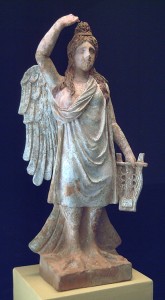Mythic Monday: Seductive Sirens
November 27, 2017
In Greek mythology, the Sirens were a group of hybrid creatures, part bird and part woman, who inhabited an island called Anthemoëssa off the coast of Italy. They were known for their enchanting but dangerous songs, which lured passing sailors to their deaths.

This statuette depicts a Siren with the legs, tail, and wings of a bird. Credit: National Archaeological Museum of Spain (licensed under CC BY-SA 3.0)
Different accounts describe the Sirens as ranging in number from two to four. Various sources tell that their mother was a Muse, a goddess of the arts and sciences; or one of the Pleiades, seven sister goddesses who became stars in the sky. The Sirens’ father may have been the river god Achelous or the sea god Phorcys. In appearance, the Sirens have been portrayed as having the bodies of birds and the heads of women; or sometimes they have the upper bodies of women, but the legs, tail, and wings of a bird. Sources often describe them as beautiful women or sea nymphs, maiden goddesses who inhabited and guarded nature’s realms. Amid all these variations, the Sirens’ music was always irresistibly alluring and consistently perilous to travelers who ventured near.
Some ancient writers told that the Sirens’ singing lured ships too close to Anthemoëssa’s shore, where they crashed on the rocks. Others told that sailors who visited Anthemoëssa became so enchanted that they eventually wasted away, oblivious to all but the music. Perhaps the best-known stories that include the Sirens are those of the Greek heroes Odysseus and Jason. In the Odyssey, an epic work by the Greek poet Homer, Odysseus was advised to plug his crew’s ears with wax before sailing past the Sirens’ island. However, Odysseus wanted to hear the Sirens’ song, so he had his men tie him to his ship’s mast. He thus escaped being fatally tempted. In another heroic tale, Jason and his nautical comrades—the Argonauts—escaped the Sirens’ pull as their ship passed Anthemoëssa because the hero Orpheus sang or played louder and more beautifully. According to ancient writers, the Sirens were fated to die if any sailor should pass by unharmed.
Some accounts tell that the Sirens once were companions of the goddess Persephone, who was kidnapped by Hades, god of the underworld. As punishment for allowing the abduction, Persephone’s mother, Demeter, imposed the Sirens’ birdlike form on them. In another version of the story, the gods gave the Sirens wings so they could fly over land and sea in search of Persephone. The Sirens sometimes were associated with the cult of the dead and were said to sing songs and prophecies related to Hades. In another story, the Sirens competed musically with the Muses, who then plucked out the Sirens’ feathers to make crowns for themselves.
In the 1890’s, French composer Claude Debussy wrote a piece of music for orchestra and female chorus titled Sirènes. According to Debussy, the piece “depicts the sea and its countless rhythms and presently, among the waves silvered by the moonlight, is heard the mysterious song of the Sirens as they laugh and pass on.”


